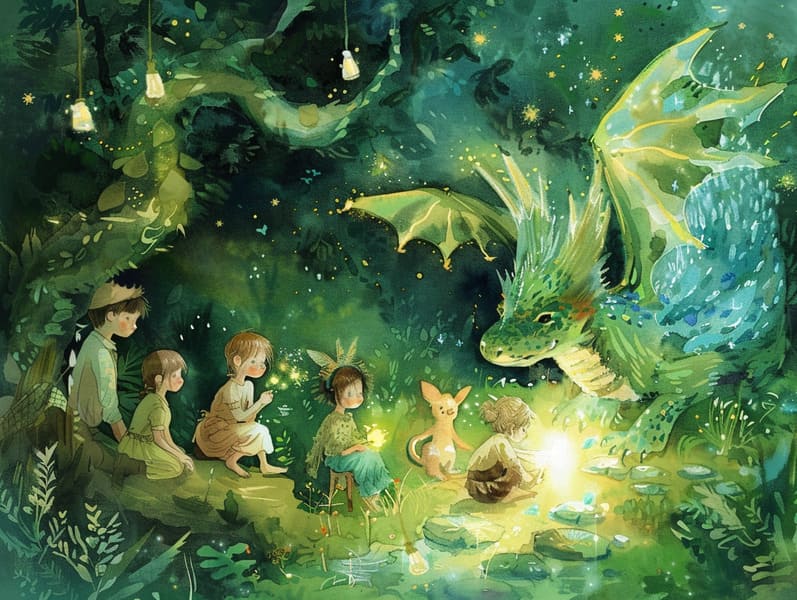The Emergence of Children's Fairy Tales and the Eternal Fascination.
The Emergence of Children's Fairy Tales and the Eternal Fascination.
Blog Article

Children's fairy tales have historical significance. These narratives have been transmitted from one generation to the next long before they were ever written down. They sprang from a variety of cultures, including Indigenous traditions. They were initially conveyed among adults, often carrying themes and messages pertaining to the societal norms and beliefs of the time.
The Grimm brothers, the two Grimm brothers, were among the first to assemble many of these beloved fairy tales. Their volume, "Grimm's Fairy Tales," included classics like "Cinder Maid," "Hansel and Gretel," and "Snow-White and Rose-Red," which have since become pillars in the world of iconic fairy tales. Similarly, H. C. Andersen's magical fairy tales, such as "The Little Mermaid," and "The Duckling's Story," have stolen hearts worldwide, solidifying their place in the pantheon of famous fairy tales.
Despite being ancient, fairy tales remain as applicable as ever, especially as children's bedtime stories. These whimsical stories are now available in multiple formats, including artistically illustrated books, delightful animations, and internet fairy tales.
Their persistent charm can be traced to several fascinating points:
Moral Lessons: Ancient fairy tales often offer important moral lessons. Narratives like "The Boy Who Cried Wolf" teach the virtue of being truthful, while "The Story of the Tortoise and the Hare" illustrate the traits of resolve and modesty. These tales offer kids clear distinctions between correct and incorrect, forming their moral compass in a kind yet lasting way.
Empathy and Understanding: Old fairy tales frequently showcase beings facing obstacles and hardships, provoking children to relate with their struggles and applaud their triumphs. For instance, "The Tale of Beauty and the Beast" highlights the benefit of looking past the exterior to know the true character of a soul, strengthening insight and comprehension.
Cultural Understanding: Many traditional fairy tales are imbued with the cultural contexts from which they originated. Exploring these tales can provide informative snapshots into different historical contexts, strengthening a sense of world insight and understanding.
Creativity and Fantasy: The magical elements in traditional fairy tales—talking animals—promote children’s innovative ideas. These fairy tales move readers to fantasy realms, invigorating inventive dreams and a sense of delight that continues a lifetime.
Old fairy tales are not only captivating but also teaching. They act as charming tools in cultivating various intellectual and emotional capacities in little ones. When timeless fairy tales are spoken, they cultivate language skills by presenting new language items and sophisticated sentence structures. This practice also develops listening abilities and mental focus, as young ones stay focused, looking forward to see what happens next.
Furthermore, deliberating the themes and characters of classic fairy tales can sharpen thought processes and logical thinking. Young readers are guided to see patterns, expect results, and make sense of cause and effect. These debates also further kids say their thoughts and feelings, boosting their emotional intelligence.
In today’s cyber age, the proliferation of digital storybooks has made these fairy tales more reachable than ever. Digital sites and online apps present vast collections of famous fairy tales that can be browsed or listened to anytime, anywhere. Fairy tales read out loud are particularly well-liked, giving an interactive method for kids to immerse in these entrancing tales. Voice books and read-out-loud stories guide characters and settings to life, often enhanced by fantastical soundtracks and tunes that boost the story adventure.
The timeless appeal of ancient fairy tales lies in their ability to alter to present days while keeping hold of their basic principles. Contemporary reinterpretations of these tales often feature more diverse characters and modern settings, making them accessible to today’s audience. However, the central morals of fortitude, humanity, and even-handedness remain unchanged, continuing to impact young readers of all ages.
Traditional fairy tales also offer a sense of comfort and closeness. They present to a methodical narrative with a definite beginning, middle, website and end, often winding up with the conclusion of conflicts and the triumph of virtue over wickedness. This uniformity can be soothing for young readers, allowing a sense of solidity in an inconstant world.
Classic fairy tales continue to entrance and coach new generations, maintaining their appeal and pertinence in modern society. As nighttime stories for kids, they grant a perfect blend of delight and instruction, furthering moral values, empathy, and creativity. The proliferation of web-based fairy tales and the sought after status of fairy tales voiced promise that these ancient stories remain available to new generations.
By safeguarding and telling these tales, we continue to venerate the rich tapestry of myths and cultural heritage. Whether you are browsing a artistically illustrated book, perusing a web-based library, or playing an narrated book, the splendor of children's fairy tales is always within reach. These narratives point out of the endless power of storytelling and its ability to bond us across time and space.
Be it you are enjoying a colorful picture book, enjoying a web collection, or listening via an read-aloud story, the delight of Grimm's fairy tales is always within reach.
These fairy tales point out of the undying effect of tales and its ability to connect us across generations and cultures, establishing a link that charms and informs alike.